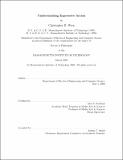Understanding expressive action
Author(s)
Wren, Christopher R. (Christopher Richard)
DownloadFull printable version (1.378Mb)
Other Contributors
Massachusetts Institute of Technology. Dept. of Electrical Engineering and Computer Science.
Advisor
Alex P. Pentland.
Terms of use
Metadata
Show full item recordAbstract
We strain our eyes, cramp our necks, and destroy our hands trying to interact with computer on their terms. At the extreme, we strap on devices and weigh ourselves down with cables trying to re-create a sense of place inside the machine, while cutting ourselves off from the world and people around us. The alternative is to make the real environment responsive to our actions. It is not enough for environments to respond simply to the presence of people or objects: they must also be aware of the subtleties of changing situations. If all the spaces we inhabit are to be responsive, they must not require encumbering devices to be worn and they must be adaptive to changes in the environment and changes of context. This dissertation examines a body of sophisticated perceptual mechanisms developed in response to these needs as well as a selection of human-computer interface sketches designed to push the technology forward and explore the possibilities of this novel interface idiom. Specifically, the formulation of a fully recursive framework for computer vision called DYNA that improves performance of human motion tracking will be examined in depth. The improvement in tracking performance is accomplished with the combination of a three-dimensional, physics-based model of the human body with modifications to the pixel classification algorithms that enable them to take advantage of this high-level knowledge. The result is a novel vision framework that has no completely bottom-up processes, and is therefore significantly faster and more stable than other approaches.
Description
Thesis (Ph. D.)--Massachusetts Institute of Technology, Dept. of Electrical Engineering and Computer Science, 2000. Also available online at the MIT Theses Online homepage <http://thesis.mit.edu/> Includes bibliographical references (p. 117-120). This electronic version was submitted by the student author. The certified thesis is available in the Institute Archives and Special Collections.
Date issued
2000URI
http://theses.mit.edu/Dienst/UI/2.0/Describe/0018.mit.etheses%2f2000-11http://hdl.handle.net/1721.1/16774
Department
Massachusetts Institute of Technology. Department of Electrical Engineering and Computer SciencePublisher
Massachusetts Institute of Technology
Keywords
Electrical Engineering and Computer Science.